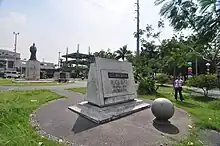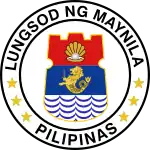Paco | |
|---|---|
District of Manila | |
.jpg.webp) Aerial view of Paco | |
 | |
| Country | Philippines |
| Region | National Capital Region |
| City | Manila |
| Congressional districts | Part of the 5th and 6th districts of Manila |
| Barangays | 43[1] |
| Founded | c. 1580 |
| Founded by | Spanish Franciscan missionaries |
| Population (2020)[2] | |
| • Total | 79,839 |
Paco, formerly known as Dilao, is a district of Manila, Philippines located south of the Pasig River, and San Miguel, west of Santa Ana, southwest of Pandacan, north of Malate, northwest of San Andres Bukid, and east of Ermita. According to the 2020 census, it has a population of 79,839 people.[2]
History

Paco was known as Dilao because of the Amaryllis plants that were once plentiful in this district.[3] Dilao or dilaw is a Tagalog word for the color yellow. Although, some sources say,[4][5] it was named Dilao or "Yellow Plaza" by the Spanish settlers because of the Japanese migrants who lived there, describing their physiognomy. Spanish Franciscan missionaries founded the town of Paco as early as 1580.[3] It was a town part of the province of Tondo, which was later renamed Manila in 1859, until 1901.
The name Dilao was used until 1791. The name San Fernando was added, making it San Fernando de Dilao.[3] In the 19th century, the town of San Fernando de Dilao was given the nickname of Paco (which means Francisco). Paco, along with Sampaloc, Santa Ana, San Juan del Monte, and San Pedro de Macati became the second largest district to become part of Manila.[6] It came to be known as Paco de Dilao[7] and eventually Paco, as it is known today.
The Japanese had established an enclave quite early or Nihonmachi at Dilao, a suburb of Manila, where they numbered between 300 and 400 in 1593. A statue of Takayama can be found there. In 1603, during the Sangley rebellion, they numbered 1,500 and 3,000 in 1606. The Franciscan friar Luis Sotelo was involved in the support of the Dilao enclave between 1600 and 1608.
The Japanese led an abortive rebellion in Dilao against the Spanish in 1606–1607. Their numbers rose again during the interdiction of Christianity by Tokugawa Ieyasu in 1614, when 300 Japanese Christian refugees under Takayama Ukon settled in the Philippines. As population assimilated to native population, numbers dimmed. However, there are today around 200,000 recorded Japanese people in the Philippines, based on modern day immigrants' records distinct from the population of colonial era immigrants which assimilated to the native population.
Paco was incorporated as a district of the newly chartered city of Manila in 1901, thus reducing from its independent municipality status.[8]
From 1907 to 1949, Paco was part of the 2nd congressional district of Manila. Reapportionment of districts made Paco part of the 4th district from 1949 to 1972. In the 1987 Constitution, Paco was split to the 5th and 6th congressional districts, with the former covering the southern half and the latter covering the northern areas.
List of Barangays
| Zone and Barangay | Administrative District | Legislative Districts |
|---|---|---|
| Zone 71: Barangays 662 and 664-A | Southern Paco | 5th District |
| Zone 73: Barangays 671, 672, 673, 674, 675, and 676 | ||
| Zone 74: Barangays 677, 678, 679, 680, 681, 682, 683, 684, and 685 | ||
| Zone 75: Barangays 686 and 687 | ||
| Zone 88: Barangays 809, 810, 811, 812, 813, 814, 815, 816, 817, 818, 819, and 820 | ||
| Zone 89: Barangays 821, 822, 823, 824, 825, 826, 827, and 828 | ||
| Zone 90: Barangays 829, 830, 831, and 832 | Northern Paco | 6th District |
Fifth District
Southern Paco
| Zone/Barangay | Land area (km2) | Population (2020 census) |
| Zone 71 | ||
| Barangay 662 | 0.01324 km2 | 1,601 |
| Barangay 664-A | 0.1585 km2 | 640 |
| Zone 73 | ||
| Barangay 671 | 0.03397 km2 | 1,227 |
| Barangay 672 | 0.09134 km2 | 3,133 |
| Barangay 673 | 0.08489 km2 | 2,764 |
| Barangay 674 | 0.1768 km2 | 1,398 |
| Barangay 675 | 0.08596 km2 | 1,988 |
| Barangay 676 | 0.1475 km2 | 1,431 |
| Zone 74 | ||
| Barangay 677 | 0.06482 km2 | 1,591 |
| Barangay 678 | 0.06117 km2 | 1,294 |
| Barangay 679 | 0.4506 km2 | 931 |
| Barangay 680 | 0.03812 km2 | 968 |
| Barangay 681 | 0.03503 km2 | 1,094 |
| Barangay 682 | 0.06793 km2 | 822 |
| Barangay 683 | 0.01948 km2 | 784 |
| Barangay 684 | 0.02984 km2 | 2,730 |
| Barangay 685 | 0.04547 km2 | 1,044 |
| Zone 75 | ||
| Barangay 686 | 0.04315 km2 | 3,250 |
| Barangay 687 | 0.03438 km2 | 1,434 |
| Zone 88 | ||
| Barangay 809 | 0.01958 km2 | 1,189 |
| Barangay 810 | 0.02513 km2 | 2,293 |
| Barangay 811 | 0.03306 km2 | 2,332 |
| Barangay 812 | 0.05098 km2 | 1,703 |
| Barangay 813 | 0.02246 km2 | 1,001 |
| Barangay 814 | 0.01700 km2 | 2,196 |
| Barangay 815 | 0.2892 km2 | 1,374 |
| Barangay 816 | 0.01067 km2 | 781 |
| Barangay 817 | 0.008420 km2 | 1,716 |
| Barangay 818 | 0.01419 km2 | 1,388 |
| Barangay 819 | 0.01458 km2 | 2,007 |
| Barangay 820 | 0.04513 km2 | 1,417 |
| Zone 89 | ||
| Barangay 821 | 0.01365 km2 | 1,995 |
| Barangay 822 | 0.01358 km2 | 897 |
| Barangay 823 | 0.01714 km2 | 3,002 |
| Barangay 824 | 0.03873 km2 | 1,302 |
| Barangay 825 | 0.05945 km2 | 388 |
| Barangay 826 | 0.02126 km2 | 1,760 |
| Barangay 827 | 0.1127 km2 | 2,661 |
| Barangay 828 | 0.01625 km2 | 2,658 |
Sixth District
Northern Paco
| Zone/Barangay | Land area (km2) | Population (2020 census) |
| Zone 90 | ||
| Barangay 829 | 0.1688 km2 | 4,226 |
| Barangay 830 | 0.4191 km2 | 5,191 |
| Barangay 831 | 0.1731 km2 | 3,350 |
| Barangay 832 | 0.09123 km2 | 2,888 |
Landmarks



The San Fernando de Dilao Church is a Roman Catholic parish church that served as the temporary pro-cathedral of the Roman Catholic Archdiocese of Manila from 2012 to 2014 during the renovations of Manila Cathedral in Intramuros.[9]
A Sikh Temple and Unilever Philippines is located on United Nations Avenue. Unilever was moved to Bonifacio Global City, Taguig. There is a ten-minute walk away is a Hindu temple at Looban Street. There are car dealers like Toyota, Ford, Hyundai, Nissan, and Honda. Presently, Dilao is traversed by Quirino Avenue. A loop road from Quirino Avenue is named Plaza Dilao to commemorate the once flourishing Japanese and the Japanese-Filipino communities and districts there in Japantown in Manila.
Paco Park, was a former municipal cemetery of the old city of Manila, and once contained the remains of Philippine national hero, José Rizal and the GOMBURZA priests.
The Osmeña Highway starts in this district and it leads to Calabarzon region via South Luzon Expressway that starts in Magallanes Interchange, Makati.
Philippine National Railways owns and operates the Paco railway station.
The Paco Public Market located along the edge of Estero de Paco was designed by William Parsons and built in 1911.
Schools include the Colegio de la Inmaculada Concepcion de la Concordia, or simple Concordia College, and the Paco Catholic School.
See also
References
- ↑ Final Results - 2007 Census of Population Archived November 20, 2008, at the Wayback Machine
- 1 2 "2020 Census of Population and Housing Results" (PDF). Philippine Statistics Authority. August 16, 2021. Retrieved August 2, 2022.
- 1 2 3 "Yahoo | Mail, Weather, Search, Politics, News, Finance, Sports & Videos". Archived from the original on October 21, 2009.
- ↑ "Paco is a place in Manila on the Map of Philippines". Archived from the original on May 7, 2010. Retrieved February 27, 2008.
- ↑ "Manila Attractions". Archived from the original on February 24, 2008. Retrieved February 27, 2008.
- ↑ "Beyond the Walls". Aenet.org. Retrieved February 23, 2019.
- ↑ ":: Malaya - The National Newspaper ::". Malaya. October 25, 2007. Archived from the original on October 25, 2007. Retrieved February 23, 2019.
- ↑ Act No. 183 (July 31, 1901), An act to incorporate the City of Manila, retrieved August 2, 2022
- ↑ Aning, Jerome (April 1, 2012). "Cathedral closed; Paco church site of main Lenten rites". Philippine Daily Inquirer. Retrieved March 20, 2023.
